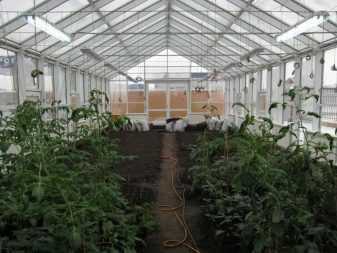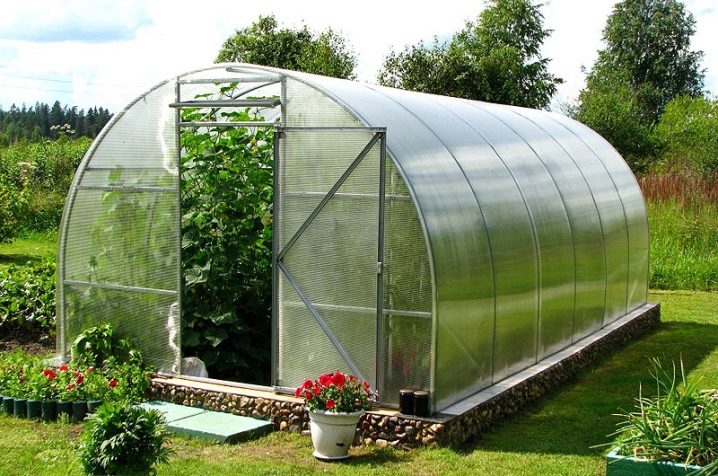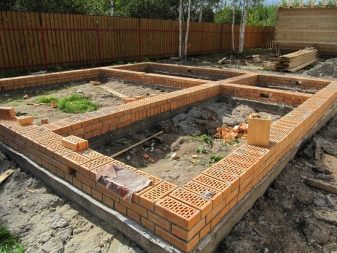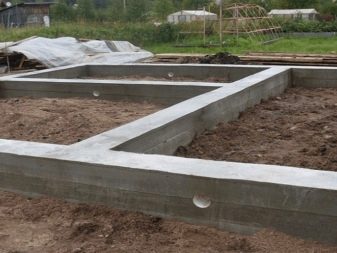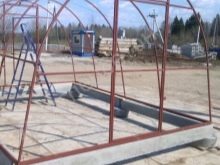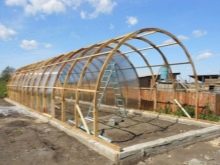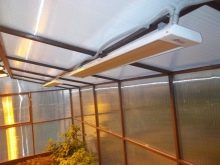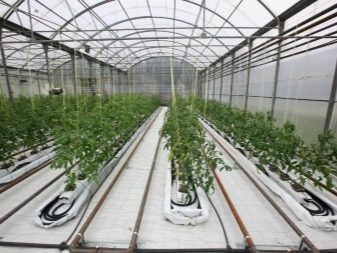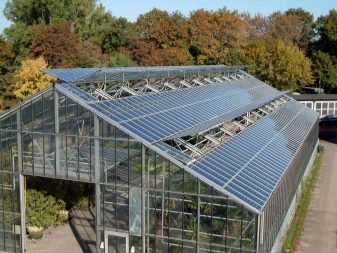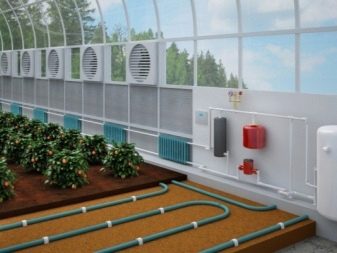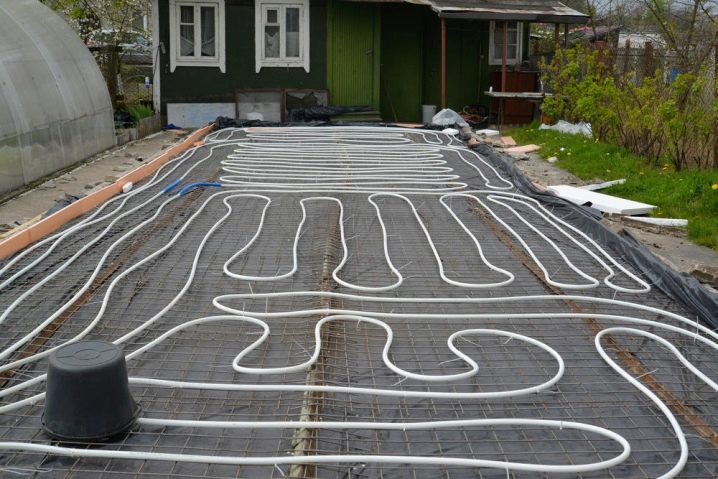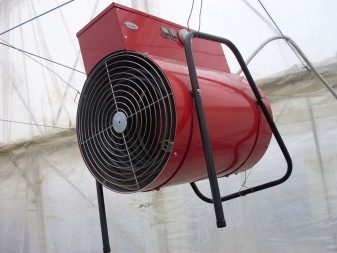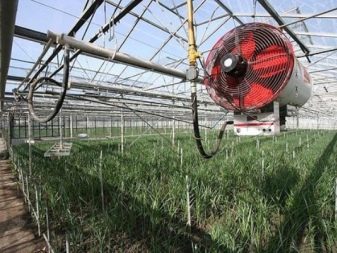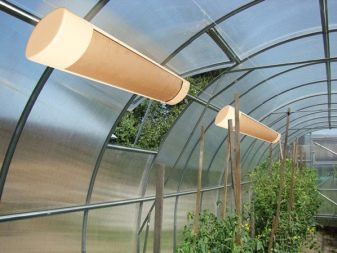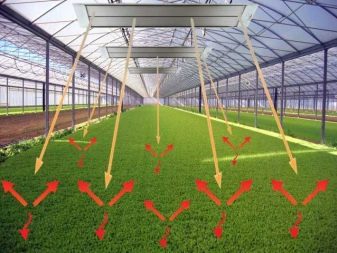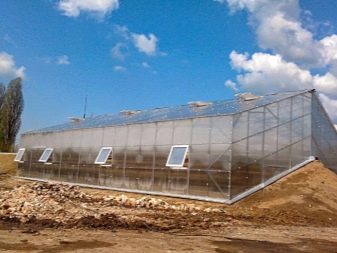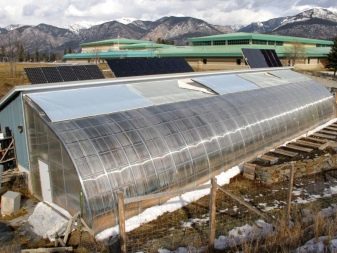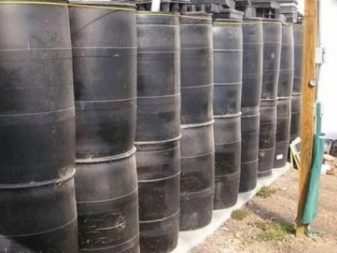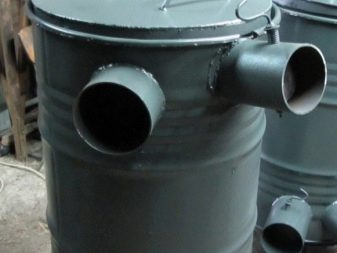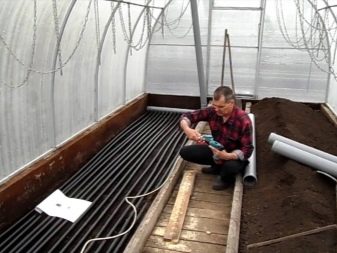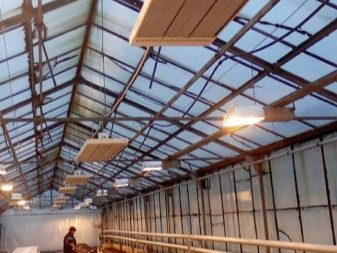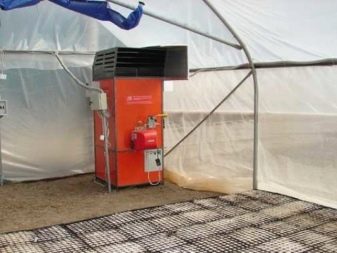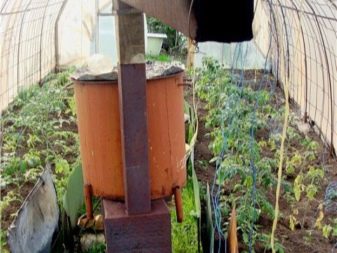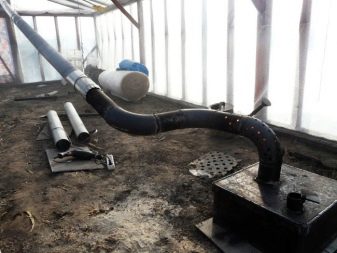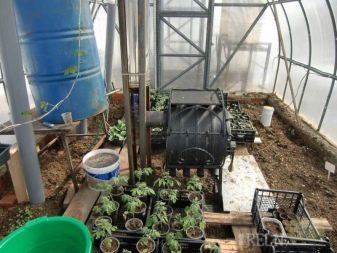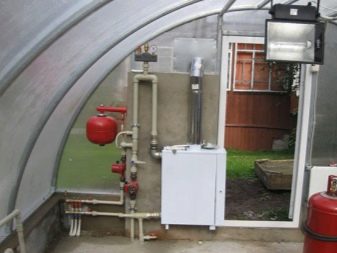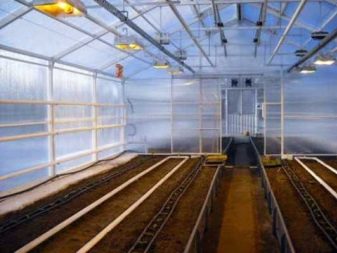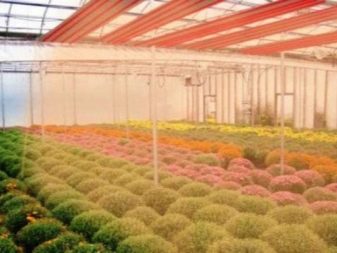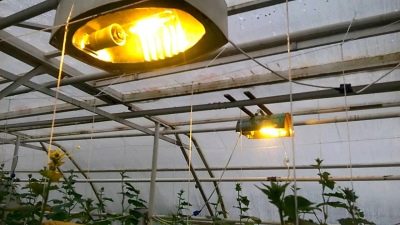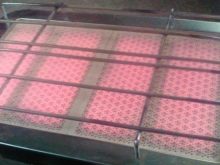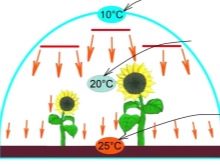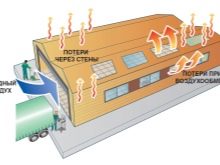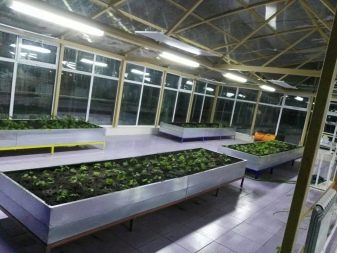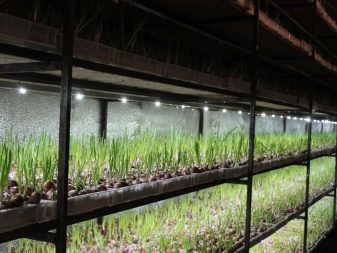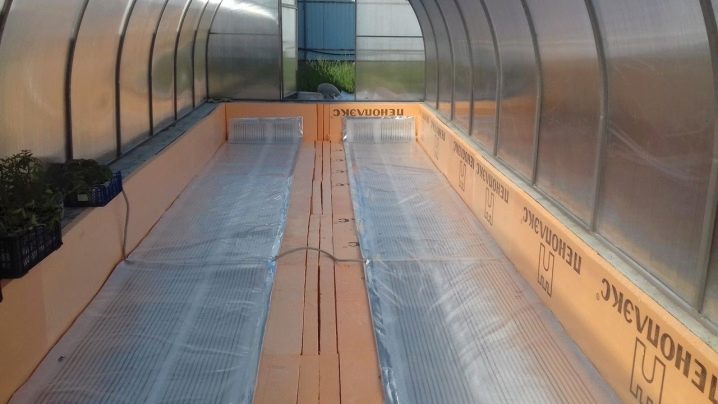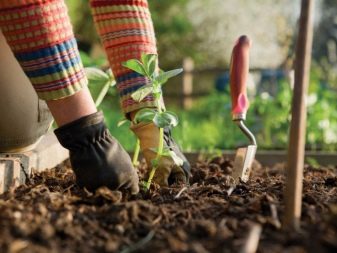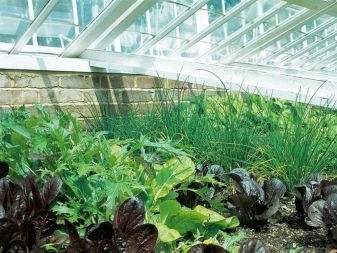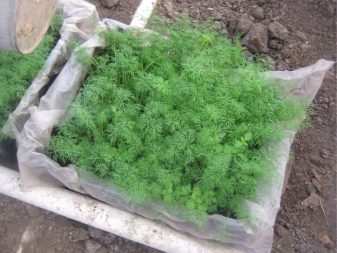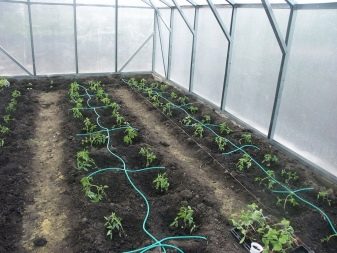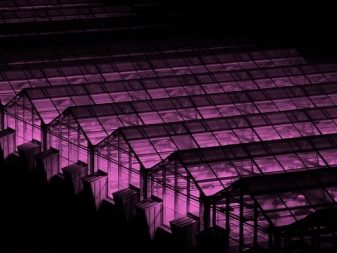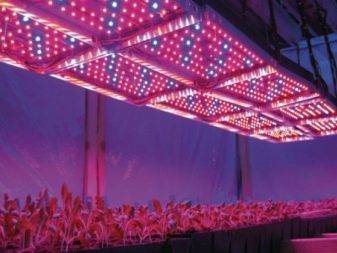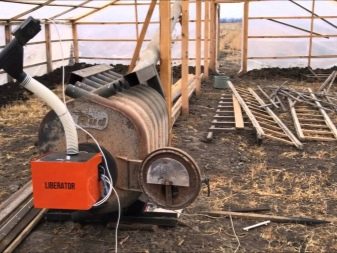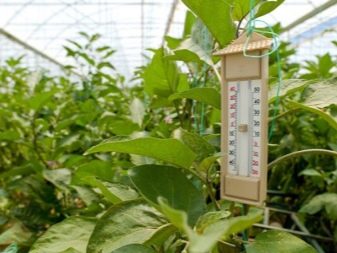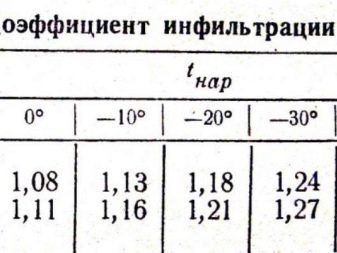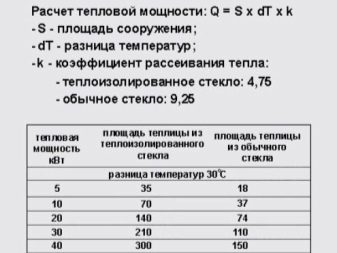Heating for the winter polycarbonate greenhouse
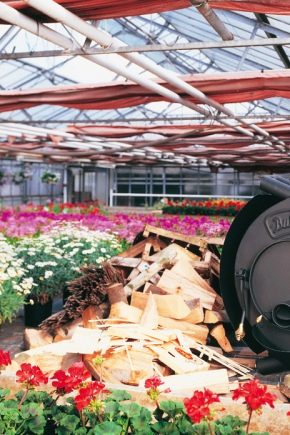
Today, many summer residents have greenhouses in which they grow various fruits and vegetables year-round, which allows them not only to have access to fresh produce all the time, but also to earn from it. But in the winter season, whatever the greenhouse, it needs heating. And today in our article we will tell about the heating of such buildings made of polycarbonate.
Design features
It should be said that whatever the greenhouse, they all have about the same principle of operation. But still such buildings have a number of features that must be in the construction. Polycarbonate greenhouse is a stationary type of building, and therefore needs two things:
- good and durable frame;
- really solid and well-made foundation foundation.
If we are talking about a year-round greenhouse, then it can not be without a capital foundation. The foundation of wood is not suitable here, because it must be periodically changed. It is best to make the foundation for such a building of brick, blocks or concrete.
Ribbon foundation is usually created around the perimeter of the structure, it is made quite simple, and its cost is small.
It is also necessary to take into account the features of the frame. The fact is that the operation of the described structure in winter time implies the presence of snow. Its accumulation on the roof of the greenhouse leads to an increase in loads on the frame base, which may cause the gradual destruction of the greenhouse or the failure of its part. For this reason, the frame must be made of metal or wood.
Ways and types
If the greenhouse is insulated correctly, then you can choose one of the types of heating. During the selection of equipment, you need to know what heat loss your greenhouse has.Calculation of heat loss can be easily requested from experts. If we talk about the most common methods of heating, then there are such options:
- water based;
- air;
- infrared;
- oven;
- electric;
- sunny.
The most common is water heating. When installing radiators and registers from such a system, there will be little confusion, because warm air will collect at the top, and below, where all the plants are located, it will be cold. Yes, and will need to solve the problem of heating the soil. To solve it, you can create a combined heating, which is considered traditional - when part of the coolant goes to the radiators, and the second - into the pipes that make the floor heating.
If desired, the coolant after leaving the radiators can be introduced into the pipes, which will be located under the pallets or directly in the beds. This method will be heated.
Another fairly common type of heating will be air. True, it has a minus - the air dries very strongly, which creates the need for constant moistening of the air.In addition, heating in such a system will also be uneven - at the top the air will be the warmest, and at the bottom the coldest. Here it is necessary to provide also a ventilation system.
An interesting solution for greenhouses can be fixtures based on the principle of infrared radiation. They will not heat the air, as the options mentioned above, but the soil and plants themselves, from which the air will already be heated. It is based on the principle of exposure to ordinary sunlight. Under these conditions, the plants will develop much better, and the leaves will not dry, which can be observed when using the options mentioned above.
In addition, this way you can heat the ground. To do this, you can find on the market special carbon heating films that produce heat in the so-called infrared range, film options work the same way as lamps of this type.
In addition, the greenhouse can be heated by sunlight. This is usually the case, since greenhouse walls are made of materials that transmit light. Heats up during the day and cools down at night. But it should be said that in early spring, in autumn and in winter, a sunny day is not so great, and the sun is not high enough beyond the horizon.To increase the efficiency of such heating, it is possible to make a slope built to the south, which will help the sun's rays better illuminate and heat the greenhouse space.
It is also possible to mount so-called heat accumulators in the greenhouse. - Barrels of water that need to be painted black. Thus, in the daytime, the water in the tanks will heat up, and at night the heat will be released.
You can also install electric heating in polycarbonate greenhouses. This option is easily implemented in several ways:
- using heating cable, which is laid in the ground;
- the use of convectors or electric heaters;
- using lamps;
- thanks to the electric boiler.
Each of the proposed methods has its own installation features, but it is believed that this type of heating is one of the most effective.
Another fairly common variant of heating - stove. It makes it possible to carry out the heating of air masses to the required temperature in all weather conditions. The main thing in this case is that the heating capacity of the furnace is commensurate with the volume of the greenhouse.As a rule, the furnace is installed in such a case in the coldest area - near the northern wall.
You can use a variety of stoves - stone, stoves, bulery. The choice depends on the preferences of the owner of the greenhouse. The distribution of air in this case can be done in various ways:
- in a natural way;
- with the use of fans;
- thanks to air ducts.
Usually the fuel is wood of various types. Options for more than enough.
Types of infrared heating
One of the most effective ways to heat a greenhouse is considered to be infrared heaters. Such a system has already managed to establish itself as a high-quality and very efficient heating option, which does not require significant costs for installation and installation. When choosing this type of heaters, two factors must be taken into account:
- air humidity level (is a particularly relevant factor);
- structural features of the greenhouse itself.
Existing infrared heaters can be divided into several categories:
- gas emitters that produce not only heat, but also carbon dioxide;
- long-wave heaters with an open heating element or aluminum plate, which provide only heat in the room;
- shortwave electric infrared models that also provide warmth to the building.
A feature of such heaters is that infrared radiation is directed not to heat the air, but directly to heat the plants, the soil, and the plants.
If we talk about the principle of operation of such a heater, it is quite simple. Its design is an infrared ceramic emitters, which are placed in a frame made of mirror-polished steel. They simply reproduce the rays that create an imitation of the light and heat of the sun. Such rays allow objects, walls, plants, to absorb heat, from which the air is then heated.
Another important characteristic of such devices is that their rays cover the maximum area, if you move them farther and farther from the floor. Naturally, the temperature of such a surface will decrease.
In addition to the above effect, which is similar to solar, this type of heaters have other advantages:
- Efficiency in the use of energy. If properly installed, you can save up to forty percent of electrical energy.
- Practicality. If there are two or three such heaters, it is possible to organize a number of zones in the greenhouse, where you can set the required temperature at any site.
- Clear distribution of warm air masses. Eliminates the uneven distribution of heat, which can be observed in a large number of conventional heaters, when warm air masses go up, while less warm ones remain at the bottom. For plants and the earth - this is a minus. In this case, it is heated items and already from them - the air.
- When using such a heater completely drafts are excluded. If you have this type of heaters near the window openings, you can compensate for heat loss without the formation of any air movement.
In addition, there are also infrared heaters in the form of a film, allowing to heat even the soil.Therefore, this category can be called the most effective.
Possibilities of the heated greenhouse
Suppose that the greenhouse will be heated, but there will not be any additional lighting in it. In such a situation, it is light, and not heat, that will become the most important criterion in the selection of crops, as well as the timing of their germination. For example, in winter, when the length of the day is short, there are frosts, and there are many cloudy days, it will be very difficult to grow something even with the help of heating.
To grow vegetables actively, they need at least twelve, or even fourteen hours of illumination. Such conditions begin to take shape somewhere after March 15, and therefore it is necessary to start planting around this time.
And since April, heating the greenhouse, you can prepare for the harvest of the first harvest. As a rule, we are talking about onions, parsley, dill, radish, kale and salads. When all this is grown, you can plant seedlings of tomatoes, and then cucumbers.
It should be said that a greenhouse that is heated but does not have light can start working about a month earlier than a normal greenhouse. Relatively acceptable conditions for plants will be when the temperature of the soil is about 6-8 degrees above zero, and all frosts stop.If you have the opportunity to constantly achieve such a temperature of the soil, then year-round vegetables and fruits are provided to you. For this reason, it is important not only to heat the air, but also to warm the ground. You can get exactly this result in three ways:
- Warm the soil with biofuels and make the so-called warm beds. Under the 30-35-centimeter layer of soil lay a layer of organic material, which decomposes during heat generation and warms the place where the roots of plants. To create such a layer, food waste, dry leaves or fresh manure may be suitable.
- Heat greenhouses with underground pipelines. However, in this case, it is necessary to provide timely watering, as this method greatly dries the ground.
- Heat the soil with infrared heaters. The method is natural, but the costs here will be serious, since there is a power consumption.
How to make yourself?
You can do it yourself greenhouse heating. An excellent example is infrared heating, as the simplest and most efficient. When calculating the equipment for heating polycarbonate greenhouses should take into account its area. To create favorable conditions for the germination of various crops, a power of 200 watts per square meter is needed.
Therefore, having an area multiplied by the required heating capacity. As a result of this, you will find out the total power that you should be guided by when purchasing infrared heaters.
Before installing such heaters should pay attention to the following nuances:
- Installation of such a heater should be carried out at a height of at least one meter.
- The farther the heater is from the floor, the more the covered area increases, and the temperature decreases.
- The distance between the heater and the plants is always best kept constant. As plants grow, the position of the heaters may be subject to adjustment.
- Heaters of this type are best mounted around the perimeter of the greenhouse, closer to the walls, since they are the coldest places of such a building.
- Between heaters should maintain a distance of about one and a half meters.
- To effectively heat such a building, you should have several heaters.It all depends on the actual size of the building you need temperature, distance, height and location of heaters.
If you do not want to use heaters of this type for heating a winter greenhouse, then you can find other options. The simplest option would be, for example, installing a stove. In this case, it is necessary to take into account only the area of the greenhouse, as well as the desired temperature.
Be sure to calculate how much it will be cost-effective.
Tips and tricks
The first point that must be noted is an advance accounting of the funds available for the purchase of the necessary system. The fact is that if in the process of its creation it turns out that you do not have enough money, then redoing the greenhouse will cost you significantly more.
It is also necessary to immediately and clearly understand what is the area of your greenhouse., and what kind of stable temperature do you want to achieve in it. In addition, one should take into account the fact of what exactly you are going to grow, and what conditions are necessary for these plants. All this is very important so that you can achieve the maximum positive effect of heating your greenhouse.
In addition, before choosing a heating system, it is necessary to calculate how its use will be economically profitable and cost-effective. This will also achieve maximum effect and get a really good harvest.
It is possible to create heating for a winter polycarbonate greenhouse with your own hands. The main thing is to have a good theoretical base and to carry out in advance all the necessary calculations in order to calculate the economic feasibility of that or a lot of heating method. You should also take into account all the features of working with a particular heating system in order to achieve maximum efficiency and effectiveness from it.
If everything is done correctly, then you will be able to enjoy fresh and high-quality fruits and vegetables grown personally by you all year round.
To learn how to install a quality greenhouse with your own hands, see the next video.
